Dazzeloids
Posted on Jun 24, 2015
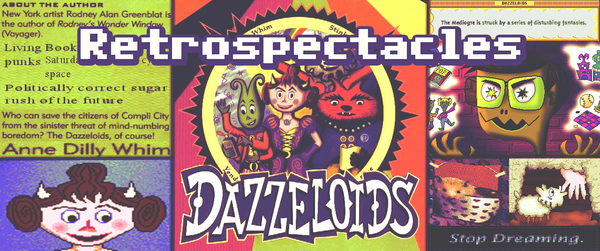
The city of Compli City is under attack! Not by giant monsters, or terrorists, or anything so simple as that, but one of the greatest threats known to man - Boredom! Our only hope? The Dazzeloids!
Dazzeloids was a 1994 children’s CD-ROM created by Rodney Alan Greenblat (better known for his contributions to the Parappa the Rapper series of rhythm games) and published by Voyager. This was before Rodney achieved the level of video game fame that Parappa had provided him, and was mostly known as an up-and-coming young artist with some children’s books and two other PC games under his belt.
Dazzeloids has never achieved much notoriety outside of people interested in Rodney’s more significant works, but we feel that in this day and age a work like the Dazzeloids deserves a special notice.
After the jump, we’ll go in-depth into the gameplay, development, and our opinions on the Dazzeloids.
The premise is as follows…
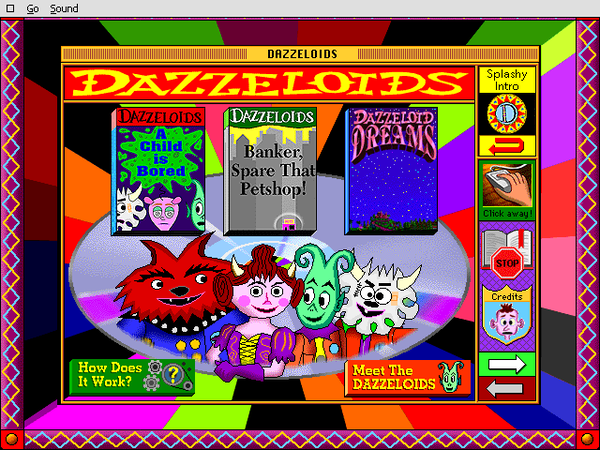
The titular Dazzeloids are a four-part team of eclectic heroes dedicated to the total eradication of boredom. They are lead by Anne Dilly Whim, the strong-headed and passionate princess-in-exile of the former nation of Chucklestein. She is joined by Yendor Talbneerg, a gadgeteering genius with a serious case of neurosis; Titan Rose, whose love of poetry is matched only by his love of smashing things with a giant mace; and Stinkabod Lamé, the clown of the team whose hobbies include slamdancing and nude gymnastics.
Together, they oppose the evil BLANDO corporation who spread boredom and mediocrity across the world. The Mediogre is the leader of BLANDO, and is the primary antagonist of the Dazzeloids. Allegedly a worm but having most of the attributes of a slug, he is obsessed with making things boring and plain and will not stop until the entire world is under his bland control. His closest lackey is Pin Bleeper, a “techno-weasel” with a knack for computer hacking and a severe impediment at personal hygiene.
Like the eternal struggle between entropy and stasis, the Dazzeloids and BLANDO are in constant conflict with each other. With the Dazzeloids firmly on the side of fun and interesting chaos against BLANDO’s stifling boredom, they always manage to prevail against the mediocrity of the Mediogre. Either through their greater creativity or the Mediogre’s own incompetence, chaos overtakes all.
The game is divided up into three mini-stories, each one with its own forking path, and a small collection of extra content including a character page. We’ll be going over the three stories in turn, going into detail on each one.
A Child Is Bored!
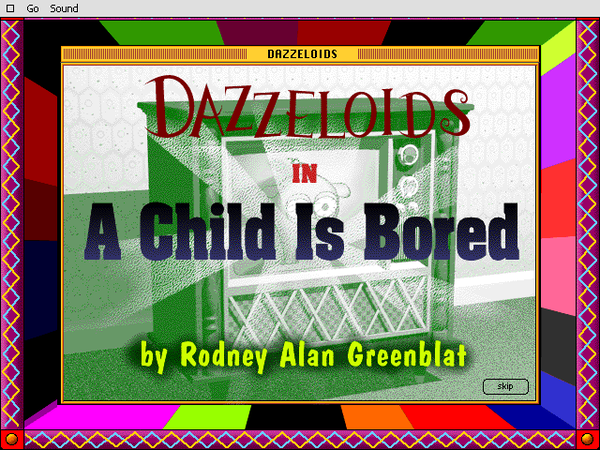
An introductory story as good as any, this establishes the apparent rules of this universe in a tale of rescue against the forces of Boredom. This adventure has the Dazzeloids uniting to save young Jeremy Gerbilman, who has been turned into a brainwashed zombie from television overdose. Note the phrase “brainwashed zombie” - you’ll be hearing it a lot.
Jumping straight out of the flashy intro sequence and into the first story brings a bit of mood whiplash. In stark contrast to the bright pizazz of the intro, the scene is of young Jeremy Gerbilman sitting alone watching TV. You can watch TV with him, but this mostly goes nowhere fast if you’re not interested in watching the life cycle of a houseplant or prunes arguing about being bored.
His concerned mother’s first instincts are to call the police, his teacher, and a local psychiatrist, who all make the same recommendation: consult the Dazzeloids. Apparently, the Dazzeloids transcend the local police department in these matters. Anne Dilly Whim sends out the rest of the Dazzeloids to investigate, and their diagnosis is grim: Jeremy has indeed became a brainwashed zombie.
From here, you can choose which of the Dazzeloids try to help poor Jeremy.
Yendor’s reaction to this whole business is to treat Jeremy like a science experiment, which is more than a little frightening. He hooks the child up to a Brain Fun Stimulation Device in order to re-stimulate the boy. You can choose the settings of the device, each one deforming the boy’s head in different amusing ways.
Titan takes the most direct route: he smashes Jeremy’s television to bits with his mace, and then reads a collection of his poetry. The Dazzeloids may stand for everything that’s good and fun, but they aren’t the best role models for kids.
Stinkabod, strangely enough, gets the most innocent conclusion: he decides he must perform the “Dance of Silliness” to inspire Jeremy to feel happy again. Though one of Jeremy’s dance animations (you can click on the both of them to have them cycle through) involves him dancing so hard that his legs detach from his body, so… God only knows what kind of reality-bending properties these guys have.
In gratitude for saving her child (and hopefully not giving him permanent trauma), Jeremy’s mother serve the Dazzeloids a “wholesome snack”… of milk and fruity pies (if you pick Yendor), “creamy corn” and melon balls (if you pick Stinkabod), or hot gravy and biscuits (if you pick Titan). Not really that wholesome, but who are we to judge?
Banker, Spare That Pet Shop!
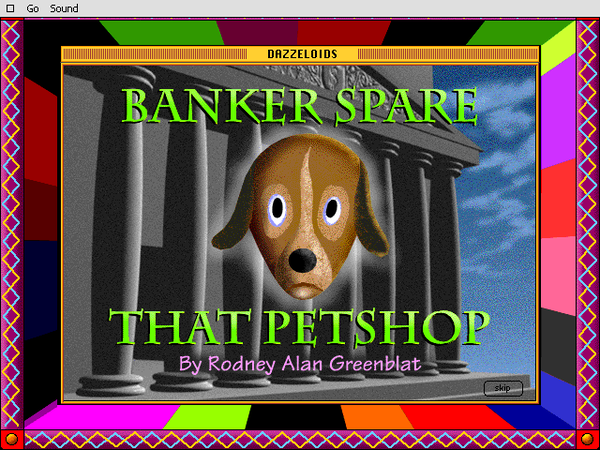
This story begins when Stinkabod Lamé’s pet hamster Shortnin’head (this name is enunciated with a great deal of skepticism) is struck with a case of the Fuzzy Rodent Flu. When they try to contact the local Probe & Poke Pet Shop (a carryover from a previous Rodney game, Wonder Window) for assistance, they discover that it’s gone missing! Anne Dilly sends out the rest of the Dazzeloids to investigate. As they arrive on the scene, they discover that the pet shop has been completely erased from this dimension.
This turns out to be the work of the Mediogre and Pin Bleeper, who are planning to cover the city in… banks. For some reason. This seems like a questionable evil plot, as two side characters mention that the town is already covered in banks, but we’ll soon learn that the Mediogre isn’t exactly the strongest on this front.
Getting back on track: The Dazzeloids are quickly targeted with the Mediogre’s “Transglumifier”, and are transglumified into another dimension. From there, the path of this story forks into three once again. You can choose who saves the Dazzeloids from their glum fate: either Anne Dilly Whim by having her invent a magical “Vibrobeam” to return them home; the Dazzeloids, who discover the lost Probe & Poke Pet Shop and warp themselves home; or the Mediogre, whose own incompetence destroys the Transglumifier and saves the heroes.
The path forks again if you pick the Dazzeloids saving themselves. Yendor overloads his Personal Distress Assistant to open a wormhole in time-space, Titan chants the Magic Sacred Chant of the Great Tomb of the Giant Swami, and Stinkabod plunges a dimensional vortex out of the toilet.
Whichever way you choose, the Dazzeloids and the pet shop both return from the void dimension, and Shortnin’head successfully recovers from his flu. The Dazzeloids and the pet shop’s owner all celebrate their success with a demonstration of the hamster’s recovered strength.
Dazzeloid Dreams

In the final chapter, we are given an in-depth exploration of each member of the Dazzeloids’ (along with the Mediogre’s) dreams. These dreams are five independent music videos, one for each character, ranging from the entertaining to downright disturbing.
Anne Dilly Whim has a strange dream about a group of trees being attacked by a horde of invading television screens with hatchets. She tries to save the trees, but they are ignorant to her attempts to help. It’s not until a rainstorm forces the electronic TVs under the shade of the trees that peace is made.
Yendor has a simple dream of electronic patterns and diagrams set to electronic music.
Titan Rose dreams of his secret crush: Anne Dilly Whim! He longs to confess his love to her, but when he finally gets a quiet moment, it is revealed who he has been chasing for so long: a frog whose head is in the same shape as Anne’s.
Stinkabod’s dream is the most confusing of the lot. It’s a music video about his childhood life on the farm, which includes a direct image of him being born and him sucking on his mother’s teat. This dream is incredibly awkward to watch and just plain bizarre.
Finally, the Mediogre has a nightmare where he is trapped in an endless maze while tormented by the knowledge that his plans always end in failure. He cries out for his mother, but nothing absolves him of his fear.
Overall
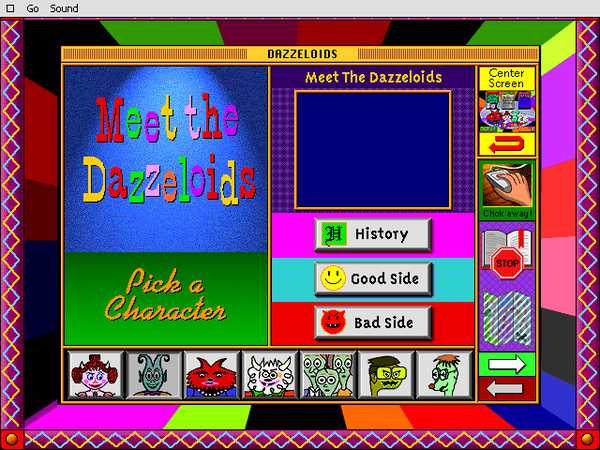
We feel like simplicity is best in this case - each individual story, although very short, contains a huge amount of charm and expression. We enjoyed most how each character was radically unique and interesting in their own ways, with no two characters sharing the same archetypes.
At first glance, the stories definitely are affected by the values dissonance presented by most media at the time. It’s desperately trying to present new media as being harmful to creativity, while being presented in a medium that normally openly embraces such apparent toxicity.
There’s a sense of self-aware irony[1] to it - most of the characters use computers and gadgets (Yendor especially so), and the Dazzeloid Dreams section is inspired by music videos (an inherently TV-related medium).
The overall effect appears to skew toward promoting media that could encourage creativity, while eschewing things like non-interactive mass-produced television. Even though it comes down firmly against television and corporatism, it’s very pro-computers as a medium for children to engage with.
Overall, the game’s message of Creativity Over Boredom is well-meant, even if it is heavily laid on. The Dazzeloids proposition that the most important thing in the world is Fun - and who can argue with that? Young children will be more than able to sympathize with the Dazzeloids’ battle versus boredom when their own lives would feel overwhelmed with the tedium of chores and school.
Development

Published in 1994 by Voyager to minimal fanfare during the first vestiges of overly-commercialized children’s computer games, Dazzeloids was unique on frankly the sole basis that it wasn’t trying too hard to be new or revolutionary. It can’t really be said that this worked out in its favor, as limited distribution and a lukewarm reception ended up leaving it in the cult favorite zone, but it’s admirable for bucking the clutches of capitalism.
The intended age range of this game is a little bit vague at times. Rodney Greenblat himself initially stated that it was for ages 6 to 10, while Voyager’s promotional website (archived here) pinned it as ages 3 and up.
After less than a year of being formally released, Greenblat and the folks at Voyager were starting to have second thoughts about its intended demographic. Now, to this day, the game is mostly remembered as an adults’ cult classic.
“We’ve been talking about not marketing Dazzeloids as a kid’s product anymore, but instead as something more for the college crowd. A wacky alternative piece of some sort.” - Rodney Greenblat
The graphics (made in Photoshop) are a bit clumsily drawn, which is standard for the time period and the medium, but still a little jarring in retrospect. The animation is choppy with a low framerate, and is marred by frequent pacing issues. The art style still manages to make the most of the limited graphical capabilities, with Greenblat’s distinct style shining through. Where it lacks in technical competency, it makes up for in charm and memorability.
The gameplay (programmed in Lingo, a common language for graphical adventure games at the time) is simple, though it’s worth noting that this is a huge compliment. The massive feature creep prevalent in edutainment gaming was starting to take its toll on all related games at this point in time, with every game even remotely for children trying to become better, flashier, and more likely to hold the attention of its playerbase.
Dazzeloids is still your standard CD-ROM storybook with all of its trappings, though it skews closer to an interactive comic book than a picture book. Each “page” of each story is dotted with plenty of hidden clickables to explore, like changing the channels on a TV set or clicking on a pie to discover a small animal hidden inside.
This is fun, but it gets a bit pixel hunt-y at times, like assembling the Vibrobeam and trying to find new things to click on in an already-cluttered screen. The distinction between clickables and background scenery is a bit arbitrary at times, and some objects play the same sound from page to page when a new sound clip would have been nice.
After the fact…
There’s only so much to ask of a production like this before it becomes evident that expectations have skewed over the years. This was almost entirely a one-man feat: Rodney Greenblat handled most of the animation, graphics, programming, music composition, and even the voice acting and sound effects.
Certainly it doesn’t compare to higher-end productions, but the Dazzeloids possesses a charm that almost none of its contemporaries had. This isn’t some kind of mass-produced corporate kid’s game designed to teach children their ABCs. This is a full-on manifesto dedicated to children having fun, to promote kids to think and play in their own way. The Dazzeloids won’t stop until all boredom is eliminated from the world… and in a time like this, we need the Dazzeloids more than ever.
I genuinely was making some good faith assumptions here, but Rodney was one of the first on the NFT hype train, so whatever, right? ↩︎
Tagged: edutainment rodney alan greenblat pc 1994